The Festivals and the Flight Angel of Vastogirardi
In Vastogirardi the festivities in honor of the patrons St. Nicholas of Bari and Our Lady of Grace
(Madonna delle Grazie) are celebrated on the 1st, 2nd and 3th of July of every year. In particular,
celebrations of Madonna delle Grazie are held on July the 1st, in the evening, and on the 2nd while July
the 3rd is entirely dedicated to St. Nicholas of Bari.
 Our Lady of Grace feast is already mentioned in a copy of the 'Brotherhood of Our Lady of the Visitation"
(Confraternita di Nostra Signora della Visitazione) statute dated 1790, but it is not known with certainty
whether that corresponds to the institution year of the celebration itself, probably because the date of the
Brotherhood founding dates back to 1742. In any case, inside the mentioned copy of the statute, one of the
Our Lady of Grace feast is already mentioned in a copy of the 'Brotherhood of Our Lady of the Visitation"
(Confraternita di Nostra Signora della Visitazione) statute dated 1790, but it is not known with certainty
whether that corresponds to the institution year of the celebration itself, probably because the date of the
Brotherhood founding dates back to 1742. In any case, inside the mentioned copy of the statute, one of the
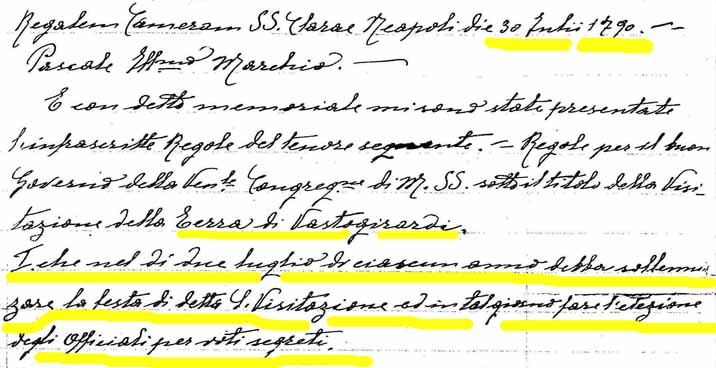 "Rules for good governance of the Venerable Congregation of Saint Mary” under the title of the “Visitation
of the Vastogirardi land" the article no. 1 reads that "on the 2nd day of July of each year [it is required]
to solemnize the remembrance of the so-called Holy Visitation....". In addition, through oral tradition it is
said that the celebration was being given for centuries on July the 2nd, as this date coincided with the day
of a large agricultural exhibition in Tragliareccia, a small hill converted to a threshing hill, facing the back
of the present church of Our Lady of Grace.
"Rules for good governance of the Venerable Congregation of Saint Mary” under the title of the “Visitation
of the Vastogirardi land" the article no. 1 reads that "on the 2nd day of July of each year [it is required]
to solemnize the remembrance of the so-called Holy Visitation....". In addition, through oral tradition it is
said that the celebration was being given for centuries on July the 2nd, as this date coincided with the day
of a large agricultural exhibition in Tragliareccia, a small hill converted to a threshing hill, facing the back
of the present church of Our Lady of Grace.
We do not know when and why but the Brotherhood has changed its name becoming "Venerable Congregation of Saint Mary
of Grace", as well as some brothers were signed in a letter dated 1891. Similarly it was not possible to find out
but most likely, since the Gregorian calendar it falls on December 6, in winter, may have been moved and merged with
that of the Madonna delle Grazie, for climatic reasons, for convenience of patron saint celebrations joint and
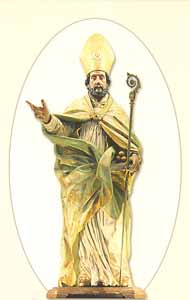 possibly also to lengthen the time course of the aforementioned agricultural fair in July. Furthermore, Our Lady of
Grace was probably celebrated on July the 2nd because this date, according to the liturgical calendar which was
reformed in 1969, corresponds to the feast of "Our Lady of the Visitation to her cousin Elizabeth,"
from which the brotherhood took the name. Within the religious celebrations in honor of the two patron
saints a national initiative of Vincenzo Liberatore, the sacred representation of the Angel, which takes
place at night on July the 1st and the morning of July the 2nd, was introduced in 1911.
possibly also to lengthen the time course of the aforementioned agricultural fair in July. Furthermore, Our Lady of
Grace was probably celebrated on July the 2nd because this date, according to the liturgical calendar which was
reformed in 1969, corresponds to the feast of "Our Lady of the Visitation to her cousin Elizabeth,"
from which the brotherhood took the name. Within the religious celebrations in honor of the two patron
saints a national initiative of Vincenzo Liberatore, the sacred representation of the Angel, which takes
place at night on July the 1st and the morning of July the 2nd, was introduced in 1911.
Liberatore began
the tradition of the flight of the angel as a special event for the inauguration of the new church of Our
Lady of Grace in 1911. The chapel was already active in the first half of 1600, as state in diocesan records,
but it is likely that it was built in 1500 when the cult of the Madonna of Grace of Grace was spreading in Italy.
The back of the church was then used as a cemetery that was closed to comply with the rules of the Edict of Saint
Claude Napoleon who around 1840 ordered them to bury the dead outside the city walls. At that time a new cemetery located
in the vicinity of the current playing field was built. By providing a larger land behind the building an opportunity
of enlargement was given to the church. The current statue of the Virgin of the Graces, venerated in the church,
dates back to 1800 and was made by the sculptor Columbus school pupils: apparently this specimen was commissioned to
replace a previous one that had been destroyed. The cult of the Virgin Mary was still followed in the village,
where the territory is enriched with various iconographic representations, among which the “Madonna of the Sabbath”
or “Vastogirardi Castellana” that according to the oral tradition was placed inside a chapel on the mountain rocks,
probably dated back to 1400: its remains and traces of the town walls are still visible in fact in the locality
called "Our Lady of the Hill", at the edges of a pine grove. Therefore, the final work was the result of a mixture
of popular piety and devotion, pride of membership, but also a considerable physical and financial effort of the
whole citizenship that has participated according to the different possibilities and in various
ways to the realization of the church, namely "who with wise counsel of the mind, those with cash assistance,
those who work with arms using their day on the temple". It is not known though at what stage the involvement
of Vincenzo Liberatore’s initiative had occurr ed, as stated on a plaque pmlaced in the church and dated 1911.
It appears that when Liberatore proposed his project to the villagers, the idea to slide a little girl in the flesh,
hanging in the air on wires had met some skepticism. But he did not discourage and in order to succeed in his intent,
like a new Abraham, decided that for the first edition taking place on July the 1st and 2nd 1911, to interpret the angel
would have been one of his daughters, and precisely the first-born Maria Ines Hyginus, known to posterity with just the
name of Mary Liberatore.
The success of the representation won the skepticism of the fellow villagers and finally
Liberatore had a positive feedback on its own initiative by the citizenship.
For the rest of the 1911-1920 decade only fragmented historical data are available about the names of the performers,
and it’s not possible to know whether this is due to shortcomings in documentary or actual suspension of the event;
however, certain and verified historical sources start being again only from 1921 and since then, apart from other
short interruptions probably due to the war, the sacred representation, especially in recent decades, has found
regularity and proven performance.
DESCRIPTION OF REPRESENTATION
The representation "Flight of the Angel" was probably chosen deliberately by Liberatore, who had the reputation of a
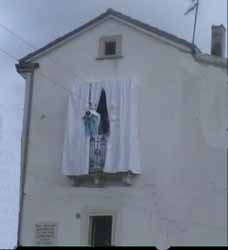 pious and religious man and therefore deeply aware of the Sacred Scriptures.
pious and religious man and therefore deeply aware of the Sacred Scriptures.
The Angel, in Vastogirardi representations,
has always been played by 4 to 6 years-old girls, although there are exceptions according to the height and size and in
any case provided that they were able to wear the special strapping by means of which the person’s body is attached to
cables. The child always wears a costume of angel iconography, consisting of a single color coat, which changes
depending on the day, and fake wings, which have recently been renovated with private donations. It is then secured
to a solid cord that currently is made of steel while initially was made of hemp. The harness is secured to a
contraption of pulleys that run on the cable in tension, firmly anchored to both the facade of the church of
Our Lady of Grace and the balcony of a house opposite and about 40 meters far; the girl’s sliding represents
the so-called "Flight." The Angel therefore "flies" from the balcony to the church, in front of which the statue
of Our Lady of Grace is previously exposed; the sliding movement is given by other two ropes pulled and driven by
two men positioned behind the statue of the Madonna and on the balcony of the house. The "Flights" are accompanied
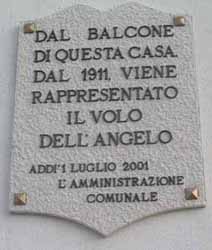 by the music of a brass band playing a soundtrack in the background, and during which the girl never turns her back
to the statue, for obvious technical reasons inherent in the machinery that doesn’t allow a return path. In the evening
of July the 1st, the first day of the festivities, after a solemn mass with panegyric appropriately ending after
nightfall, the angel dressed in white makes three “flights”. During the first, the Angel is stopped immediately
before ending on top of the Virgin’s statue, to allow him to recite a prayer that changes every year, which contains
thoughts of gratitude for the country, the girl’s family and special thoughts for event, also of international
importance, which occurred during the year. In the second flight the angel scatters incense towards the statue
and then, on the way back, even on the audience gathered below. In the third flight the angel spreads, along the path,
flower petals always first to Our Lady and then on the crowd.
by the music of a brass band playing a soundtrack in the background, and during which the girl never turns her back
to the statue, for obvious technical reasons inherent in the machinery that doesn’t allow a return path. In the evening
of July the 1st, the first day of the festivities, after a solemn mass with panegyric appropriately ending after
nightfall, the angel dressed in white makes three “flights”. During the first, the Angel is stopped immediately
before ending on top of the Virgin’s statue, to allow him to recite a prayer that changes every year, which contains
thoughts of gratitude for the country, the girl’s family and special thoughts for event, also of international
importance, which occurred during the year. In the second flight the angel scatters incense towards the statue
and then, on the way back, even on the audience gathered below. In the third flight the angel spreads, along the path,
flower petals always first to Our Lady and then on the crowd.
On the morning of July the 2nd the representation takes place at about noon, always after a solemn mass, but with some variations. The Angel is wearing a light blue dress this time; with the three flights made in the
“Confraternita di Nostra Signora della Visitazione”,
previous evening, he adds a fourth, performed as a second step and during which she offers a gift to the Virgin,
usually consisting of a gold chain, as a thank you from the family for the opportunity given to the girl to represent
the unique sacred scene, and on behalf of the whole community as a “pledge of love” and renewed devotion to the patron
saint of Vastogirardi. On both days, the “Flight” performance is followed by a procession lit by torches
at night in July the 1st which develops along a walk around the village ant that is characterized by the statue
being hand-held entirely by women and being brought into the church's in the evening, and to the Mother Church of St.
Nicholas on July the 2nd.
All of these votive processions end with fireworks and performances and particularly
evocative are the one on July the 1st and that on the evening of July the 3rd, marking the end of the holiday season,
because of course carried out at night.
Vincenzo Liberatore: The Story of a Man and His Dreams
The performance of ‘Il volo dell’Angelo’ (The Flight of the Angel) in Vastogirardi will have reached its hundredth
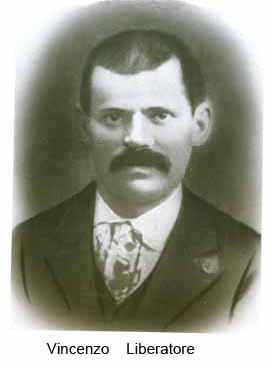 representation, and it tells the story of stubbornness and determination of Vincenzo Nicola Liberatore who followed
through with a visionary project. He did not take heed of his fellow citizens’ skepticism, and left behind a manifestation
which defies incredulity, pessimism, opposition and historical circumstances. This event, the last of its kind, continues
to resist as a pillar of popular ancient traditions which contributes to keep a rich, diversified historical and cultural
national patrimony so unique to Italy.
representation, and it tells the story of stubbornness and determination of Vincenzo Nicola Liberatore who followed
through with a visionary project. He did not take heed of his fellow citizens’ skepticism, and left behind a manifestation
which defies incredulity, pessimism, opposition and historical circumstances. This event, the last of its kind, continues
to resist as a pillar of popular ancient traditions which contributes to keep a rich, diversified historical and cultural
national patrimony so unique to Italy.
V.incenzo Liberatore was born in Vastogirardi, November 14, 1864. His parents, Loreto and Clementina Scocchera
owned a general store. He married Filomena Eufemia Mormile with whom he had six children.
Vincenzo Liberatore’s story is that of an Italian, who represents the human ideal characteristics of the Renaissance.
He was a man of strong principles and convictions, active and modern for his times. He conceived grandiose projects,
and also fought with all his strength to make them reality. His peers did not always understand the grandeur and
modernity of his projects.
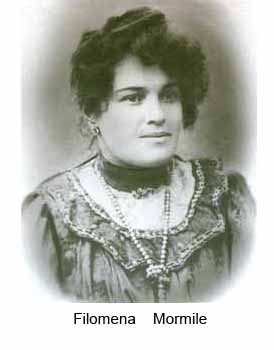
His story is that of a religious person and also that of a dreamer. He had two essential dreams, both a result of his
oniric dreams, the other of his imagination. The project, ‘Volo dell’Angelo’, was the fruit of the imagination of
a curious and ingenious man, who was fascinated by the world around him. His passion for painting also revealed a
man interested in different artistic endeavours.
Some legends developed on his account, suggested that he might have been a spectator of a similar performance
in one of his numerous trips. The project he defended so passionately contained a mixture of sacred and biblical
allusions, the use of human skill, courage and physical ability. These ideals may have touched his fervid imagination
and his spiritual devotion which urged him to create a grand ceremony for the opening of the temple that was rebuilt
and presented to his fellow citizens.
At times things do not evolve as we would like, Vincenzo Liberatore was over-indebted to restore the church,
overwhelmed by the requests of those who had repaired the church and the lack of understanding that emerged.
He was so disappointed, he left Vastogirardi never to return. Some people said he had gone to the United States of
America, but no document has ever been found other than the letter with the May 1914 date from Buenos Aires.
This was the only lettera which reached the village, where it is kept
and can be read although part of it was destroyed.
His words reveal sadness and disappointment about his departure to his fellow citizens who although had promised economic
help, did not honour their promise. What was clear, was his love for Vastogirardi and its inhabitants since this letter
was sent to the municipality of Vastogirardi and not to his family.
The people from Vastogirardi have gradually forgotten
their doubts about the represention of ‘Il volo dell’Angelo’.
Today it has become an element of pride and satisfaction to
continue on with it so that tradition and modernism can coexist. It is also considered a moment where one meets its story,
identity and roots for those who have left the town.